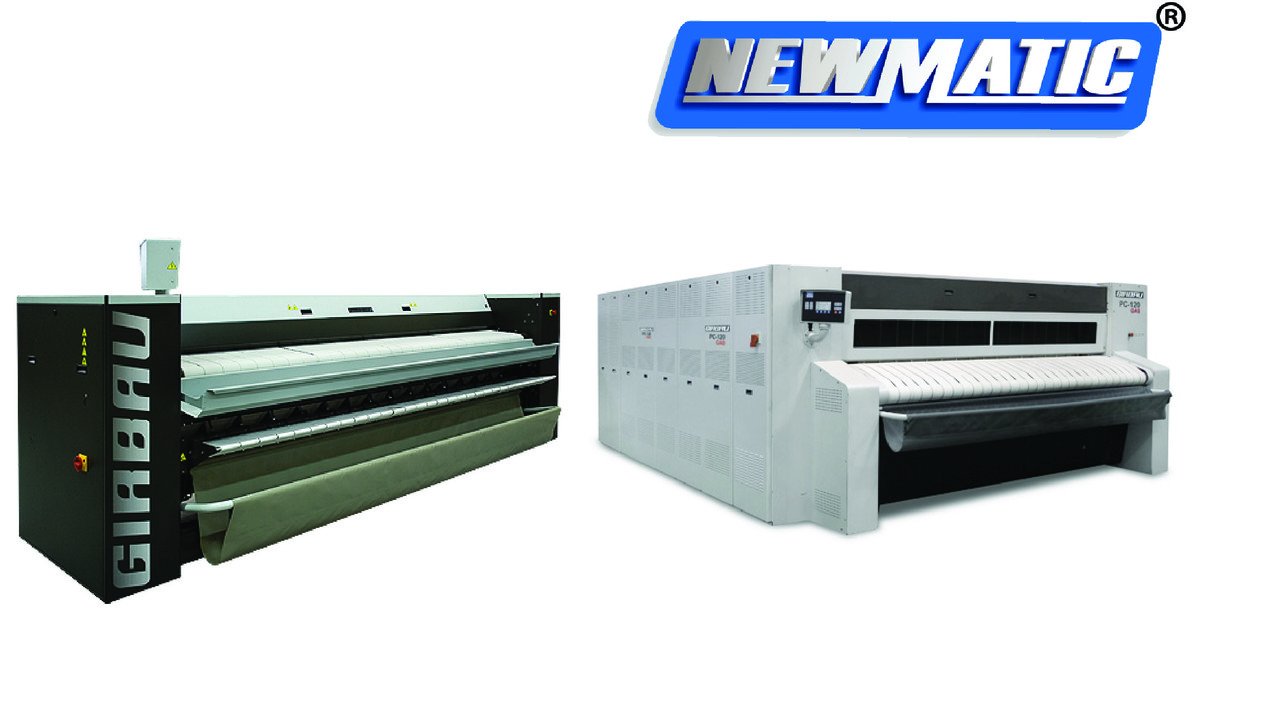
Flatwork, chest or strap-type ironers
A large percentage of fabrics processed in a professional laundry require ironing as a final step. Items such as sheets and pillowcases are routinely finished in a flatwork ironer. Generically flatwork and wall type ironers consist of padded rollers in contact with a hot (heated) metal chest.
The padding is made of textile materials that are highly resistant to high temperatures. The condition of a flatwork ironer’s padding is critical in obtaining an excellent final quality. The padding needs replacing to maintain the proper roller diameter in order to ensure contact is maintained with the chest and ensuring optimum performance.
The heat sources used are steam, electricity, gas and thermal oil.
1. Factors involved
The following factors are involved in obtaining optimum drying and ironing:
The temperature of the chest: this should be as high as possible without damaging the linen.
The nature and amount of moisture in the linen on ironing: higher residual moisture content will require more calories for optimum drying.
The temperature of the linen: the colder the linen, the higher the number of calories needed to dry it.
Adequate supply of calories: heat supply should be regulated to maintain optimum temperature. The pressure of the rollers against the chest should be as even as possible.
The speed at which items pass through the flatwork ironer should be regular and adjusted to match the temperature.
The number of rollers on the flatwork ironer and the speed setting.
Cylinder diameter: the diameter of the cylinder with the padding must be equal to that of the chest.
The degree of contact between the rollers and the chest: the greater the degree, the more surface contact there will be.
Use elasticated padding: to absorb the irregularities and differences in thickness of the linen.
Vapor suction: a higher suction leads to an increase in calorie consumption, and therefore suction should also be adjusted appropriately.
2. Wall-type ironers
Strap-type ironers can be installed in tight spaces, due to their “wall” configuration i.e. the fact that they are capable of being positioned up against a wall, meaning the linen enters and exits at the same side.
They are ironing systems aimed at markets with low to medium production requirements, and medium quality requirements.
2.1. Wall-type ironers consist basically of the following:
– A longitudinal structure supported by two side base-frames that house elements such as the control panel or extraction chamber and the steam extractor.
-A heat supply system (gas, thermal oil, electricity, steam).
– A cylinder, which is the heated element, turns driven by the motor.
– A series of ironing straps that press the linen against the cylinder, absorb the moisture and vaporize it so that it can be extracted or removed.
– An upper roller that presses the linen against the ironing straps and gives the items their ironed finish.
– A rear roller that maintains the tension of the ironing straps.
– A table equipped with feeding straps for inserting the linen.
– Trays for inserting and receiving the linen.
– A centrifugal pump for evacuating steam from the drying of linen and/or the extraction of combustion fumes in the case of gas heating.
– A system for protecting operators’ hands.
3. Chest flatwork ironers
Bed-type ironers enable high yields and a high quality finish. These machines are aimed at a highly demanding sector. They consist basically of the following parts:
– Beds and rollers.
– A set of fabric ribbons for passing the linen between the cylinders.
– A tensioning system for the ribbons.
– A motor that moves the cylinders and the input straps.
– A set of pipes, filters and/or purgers to distribute the heating fluids (steam, thermal oil, etc.)
– The corresponding electrical wiring and pneumatic system and the set of control elements.
– Linen collection tray at the exit.
3.1. Chest
The chest is the heating element, and is heated using a gas, steam or thermal oil heating system.
3.2. Cylinder
The cylinder is perforated and is covered with a fabric padding. The padding gives the cylinder elasticity, allowing it to exert an even pressure. To absorb vapors and increase performance, the cylinders incorporate an evaporation system.
3.3. Padding
The most widely used fabrics are cotton, polyester and polyamide, although recently new technologies have led to the introduction of technical polyamide fabrics that are much more resistant to high temperatures over a long period of time
4. Differences between strap-type ironers and chest flatwork ironers
4.1. The surface to be heated: In the case of strap-type ironers, the inside of the rotating cylinder is heated, whereas in the case of chest flatwork ironers, it is not the cylinder which is heated but rather the chest over which the cylinder rotates.
4.2. Ironing pressure: In the case of wall-type ironers or strap-type ironers, the linen moves between the actual roller which rotates continuously and a series of ironing straps that accompany the linen. In this way the ironing pressure is momentary, with pressure only being applied at a point in the linen’s passage over the roller (using the pressure roller), located just at the point where the linen begins to come into contact with the hot mobile roller.
In the case of chest flatwork ironers the pressure is lower, though it remains constant throughout the time the linen is passing between the rotating roller and the chest.
Newmatic 2017. All Rights Reserved
Website Design By Newmatic
Comments
Add Comment